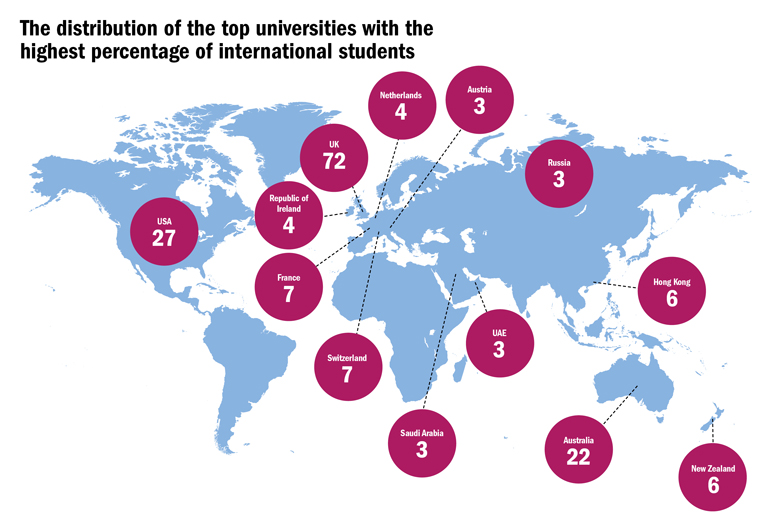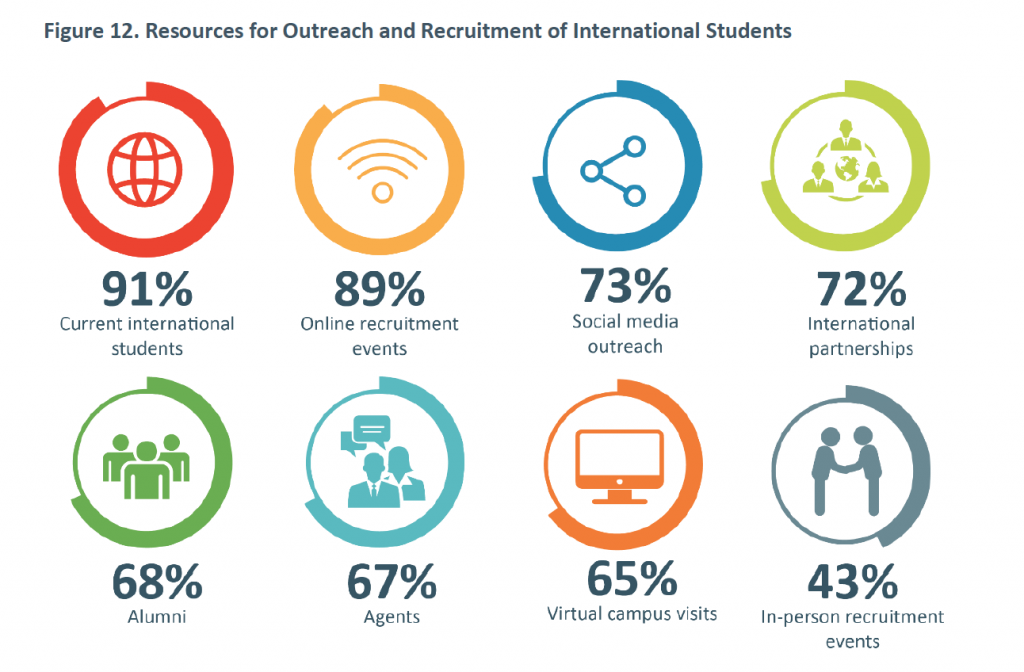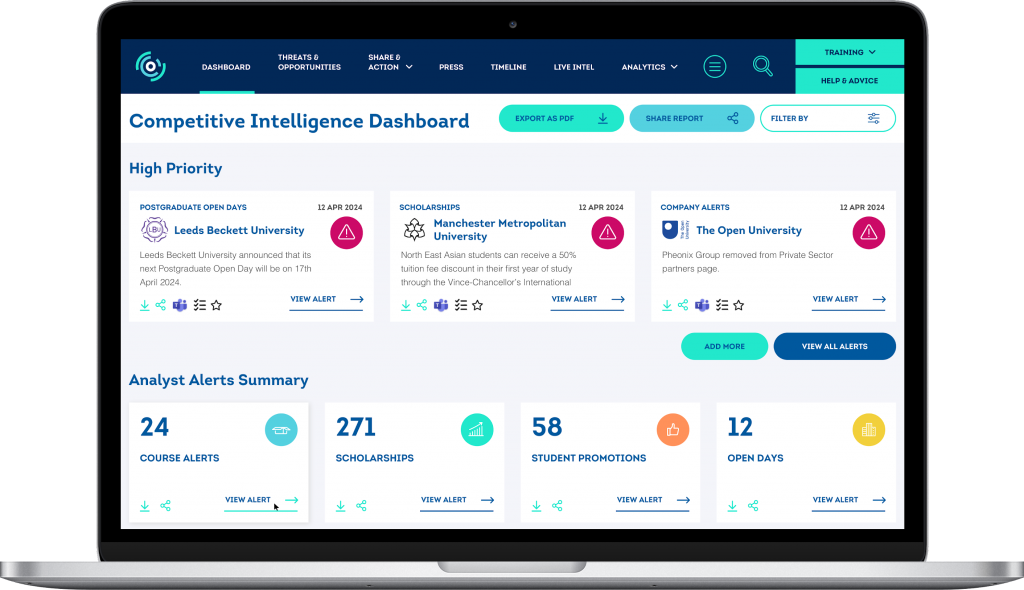Overview
In 2024, with national governments tightening student visa policies and the rise of online learning, higher education institutions (HEIs) face intensified competition for a diminishing pool of prospective students, making competitive intelligence (CI) a critical tool for strategic decision-making.
HEIs must employ data-driven strategies, leveraging CI for targeted outreach and digital engagement, and maintain academic standards to successfully navigate this competitive landscape, ensuring adaptability and innovation in student recruitment.
Introduction
In 2024, the global higher education and student recruitment sector is confronting a pivotal challenge. National governments in countries such as the US, UK, Australia, and Canada are implementing stricter student visa policies and enrolment caps.
For instance, the Canadian government announced in January 2024 that study permits issued for international students would be capped at approximately 360 000, a decrease of 35% from 2023.
Similarly, data from a recent survey of universities in the UK shows that the number of study visas issued has fallen by 33% in 2024 compared with last year, due to stricter government regulations.
The rise of online learning has also expanded student choices, forcing higher education institutions (HEIs) to differentiate themselves in order to attract both international and domestic students.
These drastic changes are compelling universities and colleges to engage in a fierce battle for a diminishing pool of prospective students.
In this highly competitive climate, competitive intelligence (CI) emerges as an indispensable strategic asset that enables institutions to make data-driven decisions and gain a critical edge.

Understanding The International Student Recruitment Landscape
The student recruitment market in 2024 is characterised by a growing sense of urgency among universities and colleges worldwide.
New government policies have been carefully crafted to balance domestic and international student intake, ensuring that local students are not displaced. But these policies have serious ramifications, given many universities’ reliance on international students.
Take for example the UK and Australia, international students account for around a quarter of the high education student population. Given the higher tuition fees paid by non-domestic students, many institutions are already engaged in cost-cutting, and a sizeable number facing financial difficulties and insolvency.
This delicate equilibrium has become a strategic focus for higher education institutions as they navigate the current landscape of student recruitment.
The implications of online learning platforms
Beyond international student enrolments becoming more tightly controlled by national governments, the rise of online learning platforms also adds another layer of complexity.
This further highlights the need for HEIs to have a deeper understanding of evolving market dynamics and competitor strategies to effectively position themselves for success.
Institutions must now pivot by employing competitive intelligence to discern and attract potential students from a reduced global pool.

Impact On International Education Standards
Restrictions on international student intake has not only intensified competition, it has also raised concerns about the potential decline in academic standards.
As universities are now forced to compete for a limited number of prospects, some institutions may be tempted to lower their admission standards to attract more international students.
This is particularly concerning because HEIs that develop a reputation for lowering standards to attract students, risk damaging their brand and losing credibility in the global market.
Therefore, while HEIs need to adapt to the evolving student recruitment landscape, it’s also crucial that they maintain their commitment to provide quality education and uphold their reputation in the face of increasing competition.
Strategies For Adaptation
To navigate this fast evolving landscape, higher education institutions must now adopt innovative strategies to maintain a competitive edge and safeguard the continued excellence of their programmes.
Below we have outlined some innovative student recruitment techniques to ensure strong enrolment numbers, and some quality assurance methods to help maintain academic excellence.
1) Innovative student recruitment techniques
A) Targeted outreach
Utilise market intelligence to identify high-potential student markets and tailor recruitment efforts accordingly.
This could involve attending international education fairs in specific regions, partnering with local high schools or educational institutions to create pathways and scholarships, and developing geo-targeted marketing campaigns.
B) Digital marketing & social media
Leverage the power of online platforms to showcase your institution’s strengths and engage with prospective students.
Utilise high-quality content like virtual tours, online open days, student testimonials, and interactive social media campaigns to create a compelling online presence.
C) Focus on student experience
Highlight the unique benefits your institution offers beyond academics — such as personalised support services, career development opportunities, and vibrant campus life.
Emphasise your holistic approach to education, where students’ academic, social, and emotional needs are met through comprehensive support programs and a nurturing community environment.
D) Leverage competitive intelligence
Harness the insights gained from competitive intelligence to craft a unique value proposition (UVP) that distinguishes your university or college in the marketplace.
This involves analysing competitor offerings, understanding market gaps, and positioning your institution’s unique features and benefits to appeal to prospective students’ aspirations and needs.
2) Maintaining Quality Assurance
A) Continuous curriculum development
Engage in ongoing curriculum review and enhancement to ensure academic programs meet current industry standards and student expectations.
This continuous development process involves faculty expertise, industry consultation, and student feedback to create a curriculum that is both relevant and rigorous.
B) Accreditation & benchmarking
Pursue and maintain accreditation from recognised bodies to benchmark against the best and demonstrate a commitment to quality education.
Securing such accreditation involves a comprehensive review of educational practices and outcomes, ensuring that your institution meets or exceeds established standards of excellence.
C) Student success tracking
Implement systems to monitor and support student academic progress and post-graduation success, ensuring alignment with educational objectives and career readiness.
By tracking these metrics, your university or college can refine its educational offerings to better prepare students for the demands of the workforce and their future careers.
D) International collaboration
Establish international collaborations to share best practices in education and incorporate global perspectives into the curriculum.
These partnerships can lead to joint programs, research opportunities, and exchange initiatives that enrich the educational experience and uphold quality standards.
Competitive Intelligence & Student Recruitment
In this increasingly competitive environment, the role of competitive intelligence (CI) becomes crucial for higher education institutions seeking to gain a competitive advantage.
Competitive intelligence provides essential data and insights, enabling HEIs to craft strategic decisions that position them advantageously in the market.
This strategic asset is vital for understanding and responding to the evolving dynamics of global education — ensuring universities and colleges can effectively attract and retain students.
Leveraging competitive intelligence platforms
Competitive intelligence platforms help users automatically collect and analyse publicly available data about their marketplace— including your competitors, the market and industry trends.
It provides you with invaluable insights and data to inform recruitment strategies, enhance competitive positioning, and help you anticipate or respond to market changes.
The benefits of using competitive intelligence
Competitive intelligence empowers higher education institutions to make data-driven decisions and gain a competitive edge in several key ways:
- Identify unique value propositions: Discover what sets your university or college apart by analysing competitors’ strengths and weaknesses.
- Benchmark against competitors: Compare and contrast your offerings with those of rivals to identify areas for growth and unique differentiators.
- Optimise recruitment strategies: Refine your approach by using market data and trend analysis to meet the evolving needs of your target audience.
- Enhance decision-making: Improve program offerings and marketing initiatives with informed, data-driven decisions.
- Anticipate regulatory changes: Stay proactive by monitoring policy shifts that could influence student recruitment strategies.
The Future of International Student Recruitment
As we look into the future of international student recruitment, it is evident that the sector is on the cusp of a transformative era.
The trajectory points towards a competitive landscape where adaptability, innovation, and strategic foresight will be the hallmarks of successful higher education institutions.
HEIs will need to embrace a more nuanced approach to student recruitment, one that goes beyond traditional methods and utilises digital outreach, personalised engagement and competitor analysis.
Data-driven recruitment strategies will become the norm, with HEIs leveraging analytics to fine-tune their outreach and connect with both international and domestic students on a deeper level.
Hybrid learning models will also continue to flourish, offering students the flexibility of online education combined with the enriching experience of on-campus life.
Recommendations for international student recruitment
In response to these trends, you should consider the following recommendations:
- Integrate competitive intelligence: Utilise competitive intelligence to inform your student recruitment strategies, anticipate market shifts, and develop a unique value proposition that sets your institution apart.
- Embrace technological advancements: Invest in technology to enhance the recruitment process, including virtual tours or AI chatbots that can provide instant assistance to prospective students.
- Cultivate a strong online presence: Develop a compelling digital footprint through engaging content, interactive platforms, and a robust social media strategy that resonates with the values and interests of the next generation.
- Foster industry partnerships: Collaborate with businesses and organisations to create internship opportunities and practical learning experiences that prepare students for their future careers.
- Prioritise student well-being: Implement comprehensive support systems that address the holistic needs of students, ensuring their mental, emotional, and academic well-being.
Higher education institutions that persistently track trends in student recruitment, monitor competitive actions, and adapt their strategies accordingly, are the institutions that will survive and thrive in 2024.



